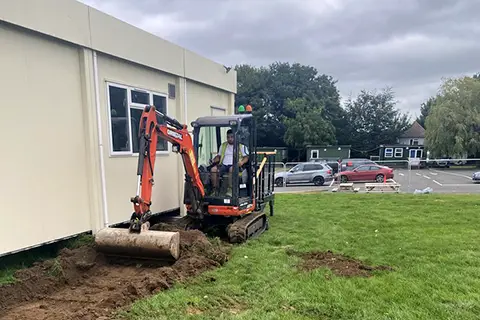The humble heroes combatting WWII’s explosive legacy
Tuesday the 27th of July started like any other day for Daniel Steinbach’s explosive ordnance disposal (EOD) teams. Carefully, methodically they surveyed a construction site in Germany, looking for unexploded ordnance (UXO).
Using magnetometer carts, the team from Igne will cover every inch of the ground on the Ludwigshafen site to ensure it’s safe before planned intrusive works begin in August.
As Daniel explains: “There are no short cuts when you’re working with explosive remnants of war (ERW) in a nation that remains littered with lethal ordnance.”
Unearthing unexploded bombs – all in a day’s work
Just before lunch on Tuesday, his colleagues stopped what they were doing when the signal went up indicating a find. Excavation followed – it’s always a delicate, fingertip operation because most ordnance unearthed across Germany is live.
Hours later, and Daniel’s team have successfully peeled back the layers of soil and sediment. For the first time since it crashed to earth from a British bomber over seventy years ago, a 250KG bomb sees the light of day.
Cordons are established, buildings are evacuated, a controlled detonation is completed by the bomb squad – and then it’s back to work for the EOD teams.
The same thing happens again two days later. Another live 250kg bomb – same city, different day.
Who clears British bombs in Germany and German ordnance in the UK?
In Germany, there’s still over 100 years worth of clearance after WWI and WWII – and that’s not counting the clearance that’s required on former military training bases across the country.
Systematically combatting this explosive legacy are the humble heroes from Igne , a commercial explosive threat mitigation company. Igne is the only company committed to post-war clearance in both Germany and the UK - on land and offshore.
The company’s survey and clearance experts work with painstaking commitment, they share ideas and equipment, and are united in their determination to protect others from deadly hazards most of us have forgotten about.
They don’t shout about what they do, they just get on with it.
UXO survey and clearance operations are lifesaving
In Germany, explosive threat mitigation is a legal requirement ahead of intrusive works – such as piling or excavation. In the UK, there is no direct requirement – the legislation is open to interpretation, and does not directly require companies to undertake UXO assessments or surveys before breaking ground - which means construction workers are placed at risk if their employers falsely assume there’s no UXO.
The consequences of uncontrolled detonations range from life changing to life ending…
In the UK in the last week alone there have been multiple finds of ordnance; weekly finds are common – but why is it still not a legal requirement to ensure a site is safe before construction begins?
Talking about the issue, Igne’s Research Manager Emily Damerell explains: “Given that 10 - 17% of all German bombs failed to perform as designed, there is a threat of unexploded ordnance on building sites across the entire UK.
“However, German bombs are not our only threat when it comes to potential UXO contamination. Over 20% of the UK landmass has been used by the military at some point. Military occupation and use has led to contamination from a wide range of munitions, from bullets to bombs.
“Usually, only the most dramatic finds make the news – such as the bomb found in Exeter earlier this year that caused a lot of damage during its clearance operation. However, items of UXO are found all across the UK every week – both on land and in rivers, canals and the wider marine environment.
“It’s true that there’s no legal requirement for the control and mitigation of UXO risk in the construction industry - but guidelines for good practice are detailed within CIRIA guideline C681.
“These guidelines provide the construction industry with a set process for the management of risk associated with UXO, from preliminary risk assessment to implementation of site-specific risk mitigation strategies.
“At Igne, we do a lot of work to raise awareness of the threat, and also to alert companies to the guidelines to ensure their staff stay safe. We know that having to consider UXO when you’re planning works is an annoyance – it’s a hindrance to timelines at best, an expensive add on at worst. But it doesn’t have to be like that.
“We start with a desktop threat assessment for our clients – this is just as likely to rule out risk as rule it in. In other words, often, a preliminary survey is all that’s needed. And yet, this step is often skipped – which can lead to unexpected finds and uncontrolled delays as work then has to stop, contractors go on standing and costs really start to rack up.
“With UXO, prevention of risk is by far the most sensible approach – for all reasons – safety, costs, timelines…”
“It’s not glamorous work, but it’s life-saving and I find that rewarding”
One member of the Igne family who’s worked extensively in Germany (when he was in the TA) and the UK, as well as on the Belgian beaches (when in the regular Army and for Igne) is EOD expert, George Wood.
Like all of his EOD colleagues, George plays an exceptionally important role – but he’s so unpretentious: “it’s not glamorous work, you sometimes work in difficult conditions, and you often work in harsh weather, sometimes you’re not really wanted on site – but it’s lifesaving work, and I find that rewarding. I won’t stop until they retire me!”
Explore more:
Whether you’re planning intrusive works on land or offshore, in the UK, Germany or beyond and you want to discuss how you can understand and mitigate any risk your staff might be exposed to – please contact Igne. We’d be delighted to support you.



